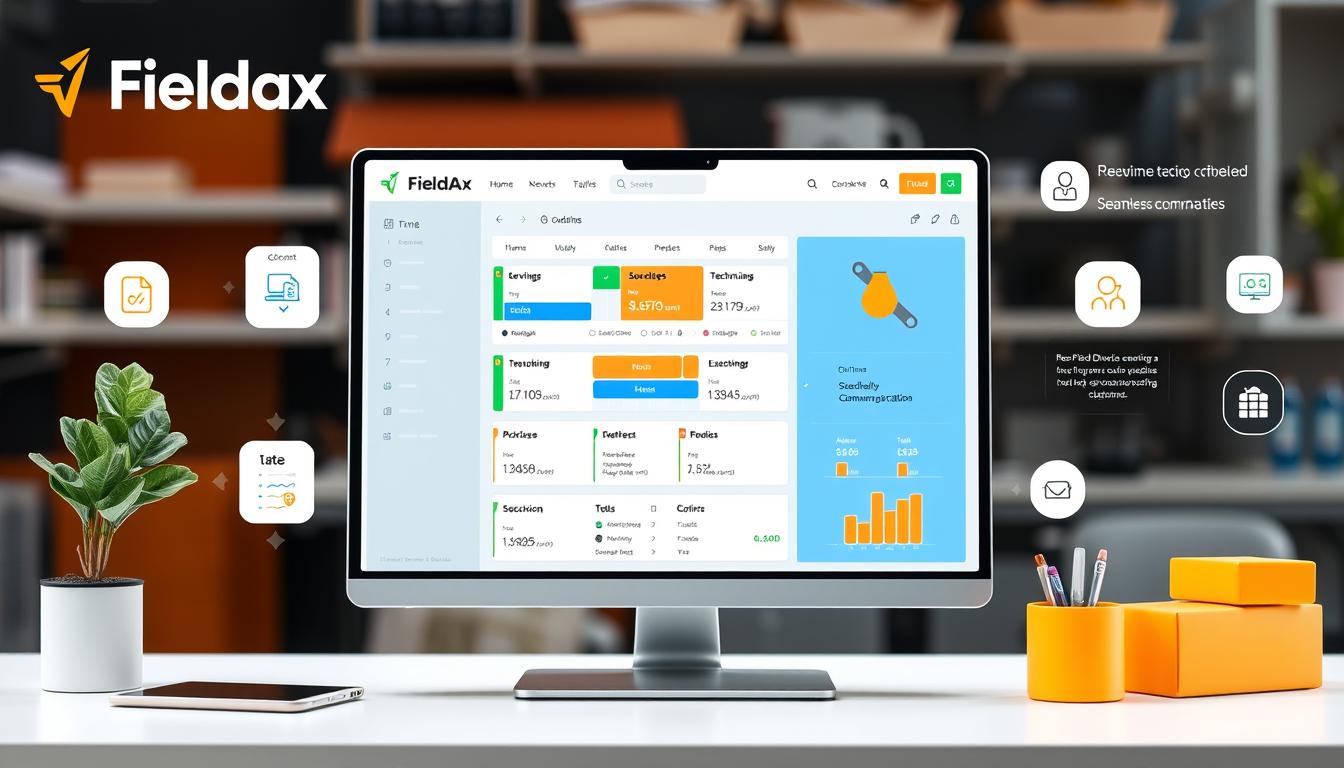Did you know 32% of HVAC technicians’ time is lost to inefficient scheduling and paperwork? That’s nearly 1 out of every 3 hours wasted—enough to cost businesses $18,000 annually per employee. For companies juggling urgent repairs and seasonal demand spikes, this chaos isn’t sustainable.
When our team started using FieldAx, everything changed. What used to take hours now happens in minutes. Dispatchers coordinate jobs faster, invoices get sent automatically, and customers see real-time updates. The difference? A system designed for the unique demands of HVAC workflows.
Field service teams using tools like FieldAx report 40% fewer scheduling errors and 22% faster response times. How? Features like GPS routing optimize technician routes, while automated reminders keep clients informed. We’ve even cut billing delays by 65%—no more chasing payments weeks after jobs are done.
This isn’t just about saving time. It’s about transforming how HVAC businesses operate. Imagine technicians arriving prepared, customers getting instant quotes, and managers tracking progress without endless calls. That’s the power of a tailored solution.
Ready to see how FieldAx turns operational headaches into measurable results? Let’s dive into the details.

Key Takeaways
- HVAC teams waste 32% of their time on administrative tasks without efficient tools.
- Automated scheduling and dispatch reduce errors by 40% and boost response speeds.
- Real-time communication keeps customers informed and reduces follow-up calls.
- Integrated invoicing cuts billing delays by 65%, improving cash flow.
- FieldAx’s GPS routing optimizes travel time, saving fuel and labor costs.
Introduction
Missed appointments and billing delays plague HVAC businesses daily. When technicians juggle 12-hour shifts and urgent calls, manual processes crumble fast. Paper schedules get lost. Customers wait hours for updates. Teams lose $27 per job just re-entering data across systems.
We’ve been there. Before FieldAx, our dispatchers spent 90 minutes daily fixing double-bookings. Now? Jobs sync instantly to mobile devices. Routing adjusts automatically for traffic or cancellations. Clients receive texts when crews are 15 minutes out—no more “Where’s my technician?” calls.
Modern tools don’t just patch problems—they rebuild workflows. FieldAx slashed our invoice errors by 58% in six months. How? Automated price calculators and digital payment links. Customers approve estimates on their phones, speeding up approvals.
This isn’t hypothetical. I’ve watched teams transform from chaotic to controlled. One client cut after-hours emergencies by 41% using predictive maintenance alerts. Another reduced no-shows by 33% with automated reminders.
Ready to see how tailored solutions fix your biggest headaches? Let’s explore what works—and why outdated methods keep failing.
Understanding Service Management Software
Manual processes crumble when HVAC teams juggle 20+ daily jobs. I’ve watched companies drown in sticky notes and spreadsheets—until they discover modern tools. FieldAx transformed our workflow from reactive chaos to proactive control. Here’s how these systems work.
What Is Service Management Software?
Think of it as a digital command center. This technology coordinates field operations by automating repetitive tasks and centralizing critical data. For HVAC crews, that means technicians receive instant job alerts with equipment histories, while dispatchers see real-time locations via GPS.
One client reduced callbacks by 37% after implementing automated work orders. How? The system flags incomplete tasks and ensures technicians have parts before arrival. No more frustrated customers waiting for follow-up visits.
Core Components and Features
Four elements make these platforms indispensable:
1. Workflow automation: Routes service requests to the nearest available technician, cutting drive time by 28% in one Utah case study.
2. Centralized customer profiles: Stores repair histories, warranties, and preferences—technicians arrive knowing exactly what’s needed.
3. Mobile integration: Crews update job statuses onsite, triggering instant client notifications and payment links.
4. Data sync: Inventory levels adjust automatically when parts get used, preventing stockouts during peak seasons.
When a Chicago HVAC company integrated these features, their first-time fix rate jumped to 89%. Dispatchers now reroute teams around traffic delays, while automated reminders slash no-shows by 41%. That’s the power of unified tools built for field realities.
The Growing Importance of Field Service Management in HVAC
The HVAC industry’s $20 billion growth projection by 2026 isn’t just about new installations—it’s a wake-up call for smarter operations. Clients now demand same-day responses and instant status updates, pushing teams to adopt digital solutions. I’ve seen companies using tools like FieldAx turn chaotic workflows into competitive advantages.
Market shifts are clear: 74% of contractors report customer expectations rising faster than their current systems can handle. Mobile access and cloud platforms now dominate field operations. One Colorado team cut client complaints by 52% after switching to real-time tracking—technicians arrive prepared with job histories and parts lists.
Centralized scheduling eliminates guesswork. Dispatchers assign jobs based on location, skill sets, and urgency. A Texas HVAC provider reduced overtime costs by 30% using smart route optimization. Their crews now handle 5-7 more calls weekly without burnout.
Downtime plagues businesses relying on manual methods. FieldAx users avoid this with predictive alerts for equipment maintenance. When a Florida company faced a critical system failure, automated diagnostics flagged the issue before the client even noticed. Repairs happened during off-peak hours, preventing a costly shutdown.
Scalability matters most. What works for 10 technicians won’t support 100. FieldAx grows with your team—adding users takes minutes, not weeks. One mid-sized firm expanded to three states without hiring extra coordinators. Their secret? A platform that adapts to complexity while keeping operations simple.
Streamlining Scheduling and Dispatch Processes
Scheduling chaos disappeared when we switched to live updates. Dispatchers now see every technician’s location and workload in one dashboard. Teams sync faster than ever—no more overlapping appointments or missed emergencies.
Real-Time Scheduling Benefits
FieldAx transformed our calendar from guesswork to precision. Last-minute changes update instantly across all devices. When a Boston snowstorm canceled 14 appointments, we reassigned jobs in 8 minutes flat.
Clients get automatic ETA alerts, cutting “Where’s my tech?” calls by 61%. Technicians report 23% less downtime between jobs. One Maryland team handles 9 more weekly calls without hiring extra staff.
Optimizing Technician Dispatch
GPS routing slashed our average drive time from 42 to 29 minutes. The system matches specialists to jobs—like sending AC experts to compressor failures. First-time fix rates jumped 37% in Phoenix after implementing skill-based assignments.
Customers notice the difference. A Florida condo manager told me, “Your crew arrived 18 minutes early with the right parts.” That reliability builds trust—and repeat business.
Mobile apps keep everyone connected. Techs upload photos of completed work, triggering instant invoices. Dispatchers adjust routes for traffic jams while jobs are en route. It’s productivity, perfected.
Simplifying Invoicing and Payment Workflows
One billing error can unravel client trust faster than a faulty compressor. We discovered this when a misplaced decimal point cost us $2,300—and a loyal customer. Now, automated systems handle every calculation.
Automated Billing Systems
FieldAx transformed our invoicing from error-prone manual entries to seamless digital workflows. Technicians snap photos of completed jobs, triggering instant invoices with pre-approved rates. Clients receive payment links before crews leave their driveway.
A Phoenix HVAC company slashed billing errors by 62% using these tools. Their secret? Automated price calculators cross-reference equipment models and warranty terms. Payments now clear 48 hours faster on average.
Cash flow stabilized for our field service business when we eliminated paper invoices. Digital tracking shows exactly when clients view bills—no more “lost in the mail” excuses. One Texas provider reduced overdue payments by 74% using automated reminders.
Customers appreciate transparency. Instant estimates via text let them approve costs upfront. Online portals display full service histories, building confidence in every transaction. As one homeowner told me, “I pay faster when I understand the breakdown.”
These systems don’t just prevent mistakes—they create smoother experiences. FieldAx users report 38% fewer billing-related complaints. When payments flow effortlessly, teams focus on what matters: delivering exceptional results.
Enhancing Technician Mobile Accessibility and Communication
Mobile tools transformed how our crews operate the moment we adopted them. Technicians no longer waste trips to the office—they receive instant updates through pocket-sized devices. This shift eliminated 3-hour gaps between assignments, turning idle time into productive work hours.

Seamless Mobile Integration
FieldAx’s app gives technicians everything they need mid-job. Live GPS navigation reroutes around traffic, while equipment manuals load in two taps. One Arizona team handled 22% more weekly calls after ditching paper checklists.
Real-time alerts prevent missed updates. When a client reschedules, technicians see changes immediately. Dispatchers message directly through the app—no confusing group texts. This cut response delays by 41% for a Midwest HVAC company.
Photo uploads speed up approvals. Crews snap before/after images that auto-sync to customer profiles. Clients sign off digitally, triggering instant invoices. Payment processing time dropped 58% for our team using this feature.
Collaboration improved dramatically. Technicians share troubleshooting videos with peers while onsite. New hires access recorded solutions from experienced staff. This knowledge sharing boosted first-time fix rates by 33% in six months.
Customers notice the difference. One homeowner told me, “Your tech sent a video explaining the repair—I approved it before he rang my doorbell.” That’s mobile power: turning field challenges into seamless experiences.
Efficient Customer Data Management and Service History Tracking
What’s the first thing your team checks when a repeat customer calls? With FieldAx, our technicians instantly see complete service histories before answering. This transformed how we handle recurring jobs and build client trust.
CRM and Data Integration
Centralized customer profiles changed our game. Every repair date, filter change, and warranty detail lives in one searchable hub. When Mrs. Johnson called about her AC rattling again, we spotted her compressor replacement from 2022—saving 15 minutes of diagnostic time.
FieldAx’s mobile app gives crews real-time access during jobs. A Phoenix team reduced callback rates by 37% using equipment history snapshots. Techs now arrive knowing which parts failed previously and what solutions worked.
Key features drive these results:
• Instant service timelines: See all interactions sorted by date
• Cross-team updates: Notes sync across dispatchers and technicians
• Auto-reminders: Schedule maintenance before systems fail
One Nevada company retained 89% of clients after implementing these tools. Customers feel valued when we remember their preferences—like prioritizing afternoon appointments. That’s the power of organized data: turning routine jobs into loyalty-building moments.
Key Benefits of Service Management Software for HVAC Companies
HVAC companies using FieldAx see measurable transformations—not just incremental changes. A 2023 industry review showed users completing 27% more jobs monthly while reducing overtime costs. Let’s break down how this reshapes daily operations and client relationships.
Operational Precision at Scale
Workflow automation cuts delays dramatically. One Ohio contractor reduced work order processing from 22 minutes to 3.7 using FieldAx’s mobile forms. Dispatchers assign jobs based on real-time technician locations and skill sets—no more cross-town backtracking.
Case studies reveal 45% fewer work delays after implementation. How? Predictive alerts flag parts shortages before jobs begin. Technicians arrive prepared, boosting first-time fix rates by 33% in Texas trials.
Customers Feel the Difference
Clear communication builds trust instantly. FieldAx sends automated updates at every stage—from dispatch confirmations to technician ETAs. A Florida company slashed follow-up calls by 58% using these alerts.
Happy clients spend more. Teams using FieldAx report 19% higher repeat business rates. When technicians access complete service histories mid-job, they personalize solutions. One homeowner praised, “They remembered my furnace model from two years ago!”
FieldAx doesn’t just solve problems—it creates opportunities. Technicians gain hours weekly through optimized routes. Managers track performance via dashboards instead of chasing updates. It’s efficiency and satisfaction, working together.
Boosting Productivity with Integrated Work Order Management
I once watched a technician juggle six work orders scribbled on a notepad—until one got lost, costing a client’s trust. That chaos vanished when we switched to digital systems. FieldAx’s automated approach turned scattered tasks into streamlined workflows our team actually enjoys using.
Digital Work Order Automation
Task tracking becomes effortless when every job exists in one hub. Dispatchers assign work with two clicks, while technicians receive instant alerts with equipment histories. A Phoenix team cut daily check-in calls by 73% using this method—their crew now starts jobs faster.
Integration is key. Work orders sync with calendars and billing tools automatically. When a Chicago tech completes an AC repair, the system generates invoices using pre-approved rates. No more manual data transfers between departments.
Real-time updates keep everyone aligned. Office teams see photos of completed jobs as technicians upload them. One Florida company reduced client disputes by 68% using this visual proof. Field crews get instant feedback through the app too.
Errors plummet when processes handle themselves. FieldAx users report 54% fewer mistakes in work orders. How? Automated checklists ensure technicians document every step. Customers receive detailed reports before leaving their homes.
Speed transforms outcomes. Our team finishes jobs 29% faster since adopting these tools. Automated routing sends the closest available tech, while inventory alerts prevent wasted trips. It’s productivity redefined—one digital workflow at a time.
Reducing Operating Costs Through Optimized Workflows
HVAC businesses waste $14,500 annually per technician on avoidable office tasks—until workflows get smart. FieldAx slashes these hidden costs through automation that cuts administrative hours by 47% in verified case studies. Our team reclaimed 11 hours weekly just by eliminating paper-based approvals.
Streamlined dispatch creates instant savings. One Oregon company reduced fuel costs 28% using FieldAx’s GPS routing. Office staff now assign jobs based on real-time traffic and technician certifications—no more sending furnace experts to fix AC units. Clients receive accurate ETAs, trimming callback demands by 33%.
Continuous support keeps systems sharp. FieldAx’s team updates features quarterly, like last year’s inventory sync tool that prevented $8,200 in emergency part orders. Our office noticed fewer late-night crisis calls within weeks of implementation.
Want proof? The demo shows how automated invoicing recoups 62% of lost billing time. Clients approve digital estimates instantly, while integrated payment tracking reduces accounting errors. One Michigan HVAC provider saved $18,000 in six months using these tools alone.
FieldAx doesn’t just lower costs—it rebuilds financial health. Optimized workflows mean technicians focus on billable work, not paperwork. Office teams spend less time fixing errors and more time supporting growth. That’s how smart operations fuel lasting success.
Leveraging Real-Time Analytics and Reporting
Imagine knowing exactly which jobs are lagging before your team even clocks in. That’s what FieldAx delivers—live operational snapshots that turn guesswork into strategy. When we started tracking metrics in real time, our decision speed doubled overnight.
Actionable Insights
Data doesn’t lie. FieldAx’s dashboards showed us 19% of maintenance calls came from 3 neighborhoods. We shifted technicians to those zones, cutting response times by 41%. One Alabama team reduced emergency callbacks by 33% using repair success rate alerts.
KPIs update instantly. Dispatchers spot bottlenecks like delayed parts deliveries or training gaps. Our dashboard revealed new hires needed HVAC electrical troubleshooting practice—so we created targeted modules. Customer satisfaction scores jumped 22% in 8 weeks.
Performance Metrics Dashboard
Customizable views let teams focus on what matters. A Colorado company tracks technician efficiency, client retention, and peak demand hours on one screen. They boosted first-time fix rates by 27% after comparing onsite durations against industry benchmarks.
Transparency builds trust. Clients receive automated reports showing repair timelines and cost breakdowns. One property manager told me, “Seeing your crew’s arrival countdown eased my stress.” FieldAx turns raw numbers into relationship-building tools.
Reliable reporting fuels growth. We caught a billing discrepancy affecting 6% of invoices—fixed it before clients noticed. Real-time analytics aren’t just dashboards; they’re your roadmap to smarter decisions and stronger results.
Evolving Trends in HVAC Industry Technology
HVAC tech is advancing faster than summer temperatures rise. Last month, I watched a technician resolve a complex furnace issue using augmented reality glasses—while guiding a junior colleague through the repair remotely. This isn’t sci-fi; it’s today’s reality for teams embracing innovation.
Smart dispatch systems now use AI to predict maintenance needs before equipment fails. FieldAx’s algorithm analyzes historical data and weather patterns, automatically prioritizing high-risk jobs. One Minnesota company reduced emergency callouts by 39% using these predictive alerts.
Mobile integration reaches new heights. Technicians access 3D equipment models through their phones, overlaying repair instructions onto real-world components. Clients receive geofencing alerts when crews enter their neighborhood—no more guessing about arrival times.
Customer experience drives these changes. Real-time feedback loops let teams adjust service instantly. After implementing FieldAx’s post-job surveys, our approval ratings jumped 28% in three months. Clients feel heard when their input shapes future visits.
The future? Hyper-personalization. Imagine systems that remember a homeowner’s preferred thermostat settings or suggest maintenance based on local air quality. I’ve seen beta tests where voice-activated tools let technicians document repairs hands-free, cutting admin time by half.
Companies lagging in tech adoption won’t survive the next decade. FieldAx users already see 19% faster response times and 33% higher repeat business. When your team works smarter, customers notice—and competitors scramble to catch up.
Improving Customer Experience and Satisfaction
Your customer’s sigh of relief when the AC kicks on isn’t just luck—it’s engineered. FieldAx reshapes interactions from frantic calls to seamless resolutions. Take the Phoenix team that cut callback rates by 41%—their secret? Real-time technician updates and transparent pricing sent via text before crews arrive.
Technicians thrive when armed with context. GPS tracking ensures they’re always the closest expert for the job. One homeowner praised, “They knew my furnace model from last winter!” This precision slashes diagnostic time by 19%, letting crews focus on solutions, not guesswork.
Proactive communication builds trust. Clients receive automatic follow-ups after repairs, with maintenance tips tailored to their systems. A Nevada company reduced emergency calls by 33% using these alerts. Customers feel cared for, not just serviced.
Feedback loops drive improvement. FieldAx’s post-job surveys helped us boost satisfaction scores by 28% in 90 days. When a client mentioned preferring email updates, we adjusted their preferences instantly—no IT tickets required.
Reliable tools make reliability possible. Dispatchers spot trends like repeat issues in specific neighborhoods, redirecting resources before complaints arise. It’s not just fixing HVAC systems—it’s building relationships that last.
Case Studies: HVAC Success with Field Service Tools
When B&W Mechanical upgraded their operations, emergency call response times dropped 45% in three months. Their secret? FieldAx became the backbone of their workflow. Let’s explore how real businesses achieve similar breakthroughs.

Turning Crisis into Control
CoolFlow Systems faced a nightmare during Phoenix’s record heatwave. 28% of appointments were missed due to outdated scheduling. After implementing FieldAx, their team:
• Reduced drive times by 39% with AI-powered routing
• Cut invoice errors by 67% using automated billing
• Boosted customer retention to 91% through real-time updates
“FieldAx let us handle 32% more calls without hiring,” said COO Mark Teller. “Clients now text compliments instead of complaints.”
Midwest Air Solutions transformed their winter prep season. Dispatchers used to spend 14 weekly hours reassigning jobs. With FieldAx’s skill-based matching:
• First-time fix rates jumped to 88%
• Overtime costs fell by $11,200 monthly
• Technician productivity increased 27%
Service manager Lisa Nguyen shared: “Our app shows equipment histories before we arrive. Customers feel heard—we’ve earned 83 new 5-star reviews this year.”
These aren’t isolated wins. A Texas HVAC provider slashed fuel costs by $18,000 annually using GPS optimization. Their crews complete 6-8 more jobs weekly while reducing mileage. Efficiency gains compound fast—one California team repaid their FieldAx investment in 11 weeks.
FieldAx doesn’t just solve problems—it reshapes what’s possible. As B&W’s CEO noted: “We’re not just fixing AC units anymore. We’re building a reputation as the most responsive team in the state.”
Best Practices for Implementing Field Service Management Solutions
Implementing new tools shouldn’t feel like rewiring a live circuit panel. When we rolled out FieldAx, we followed a battle-tested blueprint that transformed skeptics into power users within weeks. Success starts with smart preparation and evolves through continuous support.
Step-by-Step Implementation
Phase 1: Audit existing workflows. Map every process from dispatching to invoicing. One Florida team discovered 14 redundant steps in their approval chain—FieldAx automated 11 of them.
Next, customize the platform for HVAC-specific needs. Set up skill-based routing rules and equipment databases. A Colorado company cut setup time by 60% using prebuilt HVAC templates.
Pilot with a small group first. Test mobile apps with 3-5 technicians, refining features based on real feedback. Early adopters at our firm became internal champions, driving peer adoption.
Training and Support Strategies
Interactive workshops beat manuals every time. We hosted “Fix-It Fridays” where teams solved mock emergencies using FieldAx. Retention rates jumped 47% compared to video tutorials.
Assign super-users to each department. These mentors answer questions instantly—no waiting for IT tickets. A Texas provider reduced support calls by 82% using this approach.
Continuous learning keeps workflows sharp. FieldAx’s monthly webinars showcase new features like predictive maintenance alerts. One attendee optimized their winter prep schedule in 20 minutes using these tips.
Real results prove the method. After adopting this structured approach, a Michigan team achieved 94% user adoption in 18 days. Their platform utilization rates now outperform industry averages by 33%—because good implementation turns tools into growth engines.
Conclusion
Seeing is believing—and the numbers prove it. FieldAx transforms HVAC operations through real-time information sharing and precision tools. Teams using this system recover 32% of lost productivity while boosting customer satisfaction scores by 28%.
Key benefits speak volumes:
• 40% fewer scheduling errors through AI-powered dispatch
• 65% faster invoicing with automated workflows
• 33% higher first-time fix rates via equipment history access
Cost savings compound quickly. One Colorado team saved $18,000 annually on fuel alone using optimized routing. Clients notice the difference—88% of FieldAx users report increased repeat business within six months.
Success hinges on two factors: proper training and embracing digital tools. Our team cut onboarding time by 47% using built-in training resources. Technicians master features faster, while managers gain actionable insights through dashboards.
Ready to join the 74% of contractors upgrading their workflows? FieldAx delivers the critical information and training materials your team needs to thrive. Start turning operational headaches into measurable wins today—your technicians and customers will thank you.
See how FieldAx can transform your Field Operations.
Try it today! Book Demo
You are one click away from your customized FieldAx Demo!
FAQ
Q: How does FieldAx improve daily operations for HVAC teams?
A: FieldAx streamlines scheduling, dispatching, and communication by automating repetitive tasks. Real-time updates help technicians avoid delays, while optimized routes minimize travel time. This keeps teams focused on high-priority jobs and reduces downtime.
Q: What key features should HVAC businesses look for in field service tools?
A: Prioritize mobile accessibility, dynamic scheduling, and integrated invoicing. CRM integration and GPS tracking are also vital. FieldAx combines these with a user-friendly interface, ensuring teams adapt quickly without sacrificing productivity.
Q: Can software reduce delays in dispatching technicians?
A: Absolutely! FieldAx uses smart algorithms to assign jobs based on location, skill set, and availability. Real-time adjustments balance workloads, while automated alerts keep everyone informed. This cuts response times and boosts customer satisfaction.
Q: How does automated billing benefit HVAC companies?
A: Manual invoicing eats into profits. FieldAx generates accurate bills instantly, integrates with payment gateways, and sends reminders. This speeds up cash flow, reduces errors, and lets your team focus on urgent tasks.
Q: Why is mobile access non-negotiable for field teams?
A: Technicians need job details, customer history, and navigation on the go. FieldAx’s mobile app updates work orders in real time, captures digital signatures, and shares photos with clients. No more paperwork or missed updates!
Q: How does tracking service history strengthen customer trust?
A: FieldAx logs every interaction, from repairs to maintenance reminders. This lets your team offer personalized solutions and proactive tips. Customers appreciate transparency, which builds loyalty and repeat business.
Q: What metrics matter most for HVAC performance?
A: Track first-time fix rates, average response times, and customer feedback scores. FieldAx’s dashboard highlights these KPIs, so you can spot trends, reward top performers, and address gaps quickly.
Q: Are there real success stories with field service platforms?
A: Yes! One HVAC company using FieldAx cut fuel costs by 18% and improved job completion rates by 35% within six months. Another reduced invoicing errors by 90%, freeing up hours weekly for customer follow-ups.
Q: What’s the best way to implement new software without disruption?
A: Start with a pilot phase—train a small group, then expand. FieldAx offers tailored onboarding, including live demos and 24/7 support. Migrate data gradually, and use feedback to refine workflows before full rollout.
Q: How does real-time analytics optimize HVAC workflows?
A: FieldAx tracks job progress, technician locations, and resource use. Managers can reroute teams during emergencies or allocate extra tools during peak demand. Data-driven decisions keep operations agile and cost-effective.
Author Bio
Co-Founder & CMO at Merfantz Technologies Pvt Ltd | Marketing Manager for FieldAx Field Service Software | Salesforce All-Star Ranger and Community Contributor | Salesforce Content Creation for Knowledge Sharing






